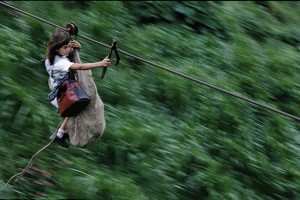Girls throughout the world have a wide range of transportation options at their disposal. In most countries, boys and girls arrive at school via car, a public school bus, or a close walk or bike ride. However, some children, like Daisy Mara, use unconventional modes of transportation to get where they need.
Daisy and her family live in Los Pinos, a remote village in the Colombian wilderness. The only school is located in another town, near the village. In order to get to this town for groceries, medicine, or in Daisy’s case, educational opportunities, residents have to either endure a two-hour hike through the jungle or use the high-wire zip-line that stretches across a large ravine. The local government refuses to build a bridge connecting the village to the town because the village population simply is not large enough.
Thus, people must rely on this zip-line. Children are taught by their parents or older siblings the best methods for crossing the ravine. Daisy, at eleven, is the oldest of her siblings and is in charge of helping her younger siblings fasten themselves into a homemade rope harness and glide down the cable where a set of tires acts as a buffer for the children to brake. The residents are mindful of the weight they carry across and use precautionary practices, such as one person at a time on the cable. Younger children, like Daisy’s youngest sister, are often carried in burlap sacks (pictured) by a more experienced rider. To date, there have not been any deaths or serious injuries due to the zip-line. It is easy to see the dangerous implications from using this type of method, but it is a part of the Los Pinos residents’ culture and tradition. The zip-line may provide the only opportunity these girls may have to receive an education.
Ripley’s Believe It or Not had the chance to film this extraordinary practice
-Casey Gymrek
Junior Girl
Girl Museum Inc.

